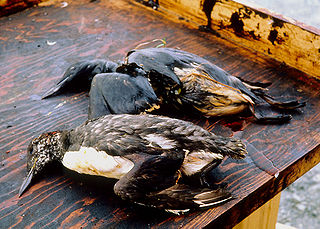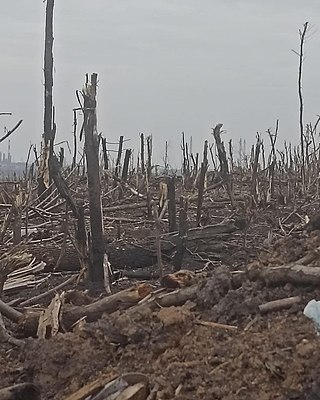
A disaster is an event that causes serious harm to people, buildings, economies, or the environment, and the affected community cannot handle it alone. Natural disasters like avalanches, floods, earthquakes, and wildfires are caused by natural hazards. Human-made disasters like oil spills, terrorist attacks and power outages are caused by people. Nowadays, it is hard to separate natural and human-made disasters because human actions can make natural disasters worse. Climate change also affects how often disasters due to extreme weather hazards happen.

A natural disaster is the very harmful impact on a society or community after a natural hazard event. Some examples of natural hazard events include avalanches, droughts, earthquakes, floods, heat waves, landslides, tropical cyclones, volcanic activity and wildfires. Additional natural hazards include blizzards, dust storms, firestorms, hails, ice storms, sinkholes, thunderstorms, tornadoes and tsunamis. A natural disaster can cause loss of life or damage property. It typically causes economic damage. How bad the damage is depends on how well people are prepared for disasters and how strong the buildings, roads, and other structures are. Scholars have been saying that the term natural disaster is unsuitable and should be abandoned. Instead, the simpler term disaster could be used. At the same time the type of hazard would be specified. A disaster happens when a natural or human-made hazard impacts a vulnerable community. It results from the combination of the hazard and the exposure of a vulnerable society.

An environmental disaster or ecological disaster is defined as a catastrophic event regarding the natural environment that is due to human activity. This point distinguishes environmental disasters from other disturbances such as natural disasters and intentional acts of war such as nuclear bombings.

A humanitarian crisis is defined as a singular event or a series of events that are threatening in terms of health, safety or well-being of a community or large group of people. It may be an internal or external conflict and usually occurs throughout a large land area. Local, national and international responses are necessary in such events.

Emergency management is a science and a system charged with creating the framework within which communities reduce vulnerability to hazards and cope with disasters. Emergency management, despite its name, does not actually focus on the management of emergencies; emergency management or disaster management can be understood as minor events with limited impacts and are managed through the day-to-day functions of a community. Instead, emergency management focuses on the management of disasters, which are events that produce more impacts than a community can handle on its own. The management of disasters tends to require some combination of activity from individuals and households, organizations, local, and/or higher levels of government. Although many different terminologies exist globally, the activities of emergency management can be generally categorized into preparedness, response, mitigation, and recovery, although other terms such as disaster risk reduction and prevention are also common. The outcome of emergency management is to prevent disasters and where this is not possible, to reduce their harmful impacts.
A chemical accident is the unintentional release of one or more hazardous chemicals, which could harm human health and the environment. Such events include fires, explosions, and release of toxic materials that may cause people illness, injury, or disability. Chemical accidents can be caused for example by natural disasters, human error, or deliberate acts for personal gain. Chemical accidents are generally understood to be industrial-scale ones, often with important offsite consequences. Unintended exposure to chemicals that occur at smaller work sites, as well as in private premises during everyday activities are usually not referred to as chemical accidents.

Environmental hazards are those hazards that affect biomes or ecosystems. Well known examples include oil spills, water pollution, slash and burn deforestation, air pollution, ground fissures, and build-up of atmospheric carbon dioxide. Physical exposure to environmental hazards is usually involuntary
Today, environmental problems in the Philippines include pollution, mining and logging, deforestation, threats to environmental activists, dynamite fishing, landslides, coastal erosion, biodiversity loss, extinction, global warming and climate change. Due to the paucity of extant documents, a complete history of land use in the archipelago remains unwritten. However, relevant data shows destructive land use increased significantly in the eighteenth century when Spanish colonialism enhanced its extraction of the archipelago's resources for the early modern global market. The Philippines is projected to be one of the most vulnerable countries to the impacts of climate change, which would exacerbate weather extremes. As the Philippines lies on the Pacific Ring of Fire, it is prone to natural disasters, like earthquakes, typhoons, and volcanic eruptions. In 2021, the Philippines ranked the fourth most affected country from "weather-related loss events", partly due to the close proximity of major infrastructure and residential areas to the coast and unreliable government support. One of the most devastating typhoons to hit the archipelago was Typhoon Haiyan, known locally as Yolanda, in 2013 that killed 6,300 people and left 28,689 injured. Congress passed the Clean Air Act of 1999, the Philippine Clean Water Act of 2004, the Climate Change Act of 2009 to address environmental issues. The country is also a signatory to the Paris Agreement. However, research has found that outside of cities, the general public doesn't feel equally informed. Environmental activists and land defenders, consisting mostly of Indigenous communities who have been attempting to bring attention to the environmental issues in the country have been met with violence or murder. As a result, the Philippines has been ranked one of the most dangerous places in the world for environmental activists. It also has one of the highest percentages of climate change denialists in the world.

African environmental problems are problems caused by the direct and indirect human impacts on the natural environment and affect humans and nearly all forms of life in Africa. Issues include deforestation, soil degradation, air pollution, water pollution, coastal erosion, garbage pollution, climate change, Oil spills, Biodiversity loss, and water scarcity. These issues result in environmental conflict and are connected to broader social struggles for democracy and sovereignty. The scarcity of climate adaptation techniques in Africa makes it the least resilient continent to climate change.
The National Oil and Hazardous Substances Pollution Contingency Plan or National Contingency Plan (NCP) is the United States federal government's blueprint for responding to oil spills and hazardous substance releases. It documents national response capability and is intended to promote overall coordination among the hierarchy of responders and contingency plans.
Climate risk is the potential for problems for societies or ecosystems from the impacts of climate change. The assessment of climate risk is based on formal analysis of the consequences, likelihoods and responses to these impacts. Societal constraints can also shape adaptation options. There are different values and preferences around risk, resulting in differences of risk perception.

The Philippines has five types of climates: tropical rainforest, tropical monsoon, tropical savanna, humid subtropical and oceanic. The country overall is characterized by relatively high temperature, oppressive humidity and plenty of rainfall. There are two seasons in the country: the wet season and the dry season, based upon the amount of rainfall. This is also dependent on location in the country as some areas experience rain all throughout the year. The warm months of the year are March through October; the winter monsoon brings cooler air from November to February. May is the warmest month, and January, the coolest.

Environmental issues are disruptions in the usual function of ecosystems. Further, these issues can be caused by humans or they can be natural. These issues are considered serious when the ecosystem cannot recover in the present situation, and catastrophic if the ecosystem is projected to certainly collapse.

A hazard is a potential source of harm. Substances, events, or circumstances can constitute hazards when their nature would potentially allow them to cause damage to health, life, property, or any other interest of value. The probability of that harm being realized in a specific incident, combined with the magnitude of potential harm, make up its risk. This term is often used synonymously in colloquial speech.

An industrial fire is a type of industrial disaster involving a conflagration which occurs in an industrial setting. Industrial fires often, but not always, occur together with explosions. They are most likely to occur in facilities where there is a lot of flammable material present. Such material can include petroleum, petroleum products such as petrochemicals, or natural gas. Processing flammable materials such as hydrocarbons in units at high temperature and/or high pressure makes the hazards more severe. Facilities with such combustible material include oil refineries, tank farms, natural gas processing plants, and chemical plants, particularly petrochemical plants. Such facilities often have their own fire departments for firefighting. Sometimes dust or powder are vulnerable to combustion and their ignition can cause dust explosions. Severe industrial fires have involved multiple injuries, loss of life, costly financial loss, and/or damage to the surrounding community or environment.
Belonging to the United Nations Environment Programme (UNEP), Northwest Pacific Action Plan (NOWPAP) is a cooperative framework where countries co-sharing Northwest Pacific are grouped for region-suited solutions to deteriorating coastal and marine environment, in the context of an UNEP' global initiative, the Regional Seas Programme (RSP).

Coastal hazards are physical phenomena that expose a coastal area to the risk of property damage, loss of life, and environmental degradation. Rapid-onset hazards last a few minutes to several days and encompass significant cyclones accompanied by high-speed winds, waves, and surges or tsunamis created by submarine (undersea) earthquakes and landslides. Slow-onset hazards, such as erosion and gradual inundation, develop incrementally over extended periods.

Disaster preparedness in museums, galleries, libraries, archives and private collections, involves any actions taken to plan for, prevent, respond or recover from natural disasters and other events that can cause damage or loss to cultural property. 'Disasters' in this context may include large-scale natural events such as earthquakes, flooding or bushfire, as well as human-caused events such as theft and vandalism. Increasingly, anthropogenic climate change is a factor in cultural heritage disaster planning, due to rising sea levels, changes in rainfall patterns, warming average temperatures, and more frequent extreme weather events.

Climate change is having serious impacts in the Philippines such as increased frequency and severity of natural disasters, sea level rise, extreme rainfall, resource shortages, and environmental degradation. All of these impacts together have greatly affected the Philippines' agriculture, water, infrastructure, human health, and coastal ecosystems and they are projected to continue having devastating damages to the economy and society of the Philippines.

The Russian invasion of Ukraine has led to ongoing widespread and possibly serious and long-term environmental damage. The Ukrainian government, journalists and international observers describe the damage as ecocide.














